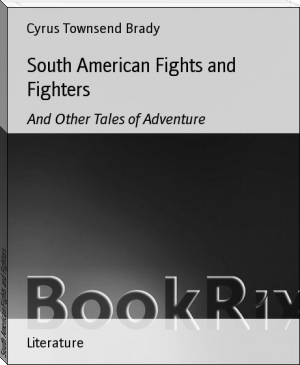South American Fights and Fighters, and Other Tales of Adventure by Brady (rosie project .txt) 📕

Read free book «South American Fights and Fighters, and Other Tales of Adventure by Brady (rosie project .txt) 📕» - read online or download for free at americanlibrarybooks.com
- Author: Brady
Read book online «South American Fights and Fighters, and Other Tales of Adventure by Brady (rosie project .txt) 📕». Author - Brady
We leave the field of conjecture, however, and meet him in far-off America in 1510 as an officer under Alonzo de Ojeda—that Don Quixote among discoverers. His qualities had obtained for him some preferment, for when Ojeda left the miserable remnants of his colony at San Sebastian on the Gulf of Darien, and returned to Cuba for help, Pizarro was put in charge, with instructions to wait a certain time, and if succour did not reach him to leave. He waited the required time, indeed waited longer, until enough people died to enable the brigantine that had been left with them to carry the survivors, and then sailed away. He was a member of Encisco's expedition to Darien, in which he fell in with the youthful and {56} romantic Vasco Nu�ez de Balboa. With Balboa he marched across the Isthmus, and was the second white man to look upon the Great South Sea in 1513. Subsequently, he was an officer under that American Nero, Pedro Arias de Avila, commonly called Pedrarias, the founder and Governor of Panama, the conqueror of Nicaragua and parts adjacent. Oviedo says that between his seventieth year, which was his age when he came to America, and his eighty-sixth year, when he died, the infamous Pedrarias caused more than two million Indians to be put to death, besides a numerous lot of his own countrymen. If we lop off two ciphers, the record is still bad enough.
In 1515, Pizarro and Morales, by direction of Pedrarias, made an expedition to the south of the Gulf of San Miguel, into the territory of a chieftain named Biru, from whom they early got into the habit of calling the vague land believed to exist in the South Sea, the "Land of Biru," or Peru. It was on this expedition that the Spaniards, hotly pursued by the natives, stabbed their captives one by one and left them dying at intervals in the pathway to check pursuit. The practice was effective enough and the action throws an interesting light on the Spanish conquistador in general and Pizarro in particular.
It fell to the lot of Pizarro also to arrest his old captain, Balboa, just as the latter was about to sail on a voyage of discovery to the fabulous gold country of Peru in 1517.[1] When Balboa and Pizarro had crossed the Isthmus six years before, the son of the Cacique Comagre, observing their avidity for gold, told them {57} that it abounded in a mysterious land far toward the south, and the young Indian made a little clay image of a llama further to describe the country.
To conquer that El Dorado had been Balboa's cherished dream. Well would it have been for the country had not the jealousy of Pedrarias cut short Balboa's career by taking off his head, thus forcing the enterprise to be undertaken by men of coarser mould and meaner clay. It does not appear that Pizarro had any hand in the judicial murder of Balboa, and no reflection can be made on his conduct for the arrest, which was simply a matter of military duty, probably as distasteful to Pizarro as it was surprising to Balboa.
II. The Terrible Persistence of Pizarro
In 1519, Pizarro was living in Panama in rather straightened circumstances. His life had been a failure. A soldier of fortune, he possessed little but his sword. He was discontented, and although now nearly fifty years of age, he still had ambition. With remembrance of what he had heard the young Indian chief tell Balboa, constantly inciting him to a further grapple with hitherto coy and elusive fortune, he formed a partnership with another poverty-stricken but enterprising veteran named Diego de Almagro, whose parentage was as obscure as Pizarro's—indeed more so, for he is reputed to have been a foundling, although Oviedo describes him as the son of a Spanish laboring man. The two men supplemented each other. Pizarro, although astute and circumspect, was taciturn and chary of speech, though fluent enough on occasion; he was slow in making up his mind, too, but when it {58} was made up, resolute and tenacious of his purpose. Almagro was quick, impulsive, generous, frank in manner, "wonderfully skilled in gaining the hearts of men," but sadly deficient in other qualities of leadership. Both were experienced soldiers, as brave as lions and nearly as cruel as Pedrarias himself—being indeed worthy disciples of his school.
The two penniless, middle-aged soldiers of fortune determined to undertake the conquest of that distant empire—a stupendous resolution. Being almost without means, they were forced to enlarge the company by taking on a third partner, a priest named Luque, who had, or could command, the necessary funds. With the sanction of Pedrarias, who demanded and received a share, largely gratuitous, in the expedition, they bought two of the four vessels which Balboa had caused to be taken to pieces, transported them across the Isthmus, then set them up again, and relaunched in the Pacific. Enlisting one hundred men under his banner, Pizarro set sail with the first vessel on the 14th of November, 1524. Almagro was to follow after with re�nforcements and supplies in the second ship. One Andagoya had made a short excursion southward some time before, but they soon passed his latitude and were the first white men to cleave those southern seas.
With only their hopes to guide them, without pilot, chart or experience, being, I suspect, indifferent sailors and wretched navigators, they crept along the forbidding shore in a crazy little ship, landing from time to time, seeing no evidence of the empire, being indeed unable to penetrate the jungles far enough to find out much of anything about the countries they passed. Finally, at one place, that they afterwards called "Starvation {59} Harbor," the men rebelled and demanded to be led back. They had seen and heard little of importance. There seemed to be nothing before them but death by starvation.
Pizarro, however, who has been aptly described as "terribly persistent," refused to return. He sent the ship back to the Isles of Pearls for provisions, and grimly clung to the camp on the desolate shore. When twenty of his men were dead of starvation, the ship came back with supplies. In one of their excursions, during this wait at Starvation Harbor, they had stumbled upon and surprised an Indian village in which they found some clumsy gold ornaments, with further tales of the El Dorado to the southward. Instead of yielding to the request of his men that they immediately return in the ship, therefore, the indomitable Spaniard made sail southward. He landed at various places, getting everywhere little food and less gold, but everywhere gaining more and more confirmation that the foundation of his dreams was not "the baseless fabric of a vision."
In one place they had a fierce battle with the Indians in which two of the Spaniards were killed and a large number wounded. Pizarro now determined to return to Panama with the little gold he had picked up and the large stories he had heard, there to recruit his band and to start out again. Almagro meanwhile had set forth with his ship with sixty or seventy additional adventurers. He easily followed the traces of Pizarro on the shore but the ships did not meet. Almagro went farther south than Pizarro. At one landing-place he had a furious battle with the natives in which he lost an eye. He turned back after reaching the mouth of the river San Juan in about the fourth {60} parallel of north latitude. He, too, had picked up some little treasure and a vast quantity of rumor to compensate for his lost optic and bitter experience. But the partners had little to show for their sufferings and expenditures but rumors and hopes.
Pedrarias in disgust withdrew from the expedition for a price, which, with the money necessary to send out a second expedition, was furnished through Luque by the Licentiate Espinosa. About September, 1526, with two ships, the two captains set forth once more. This time they had with them a capable pilot named Ruiz. They avoided the coast and steered direct for the mouth of the San Juan River. Pizarro surprised a village here, carried off some of the natives, and a considerable amount of gold. This Almagro, as the best "persuader," took back to Panama in the hope that by exhibiting it he could gain much needed re�nforcements for their expedition.
The ships were very much undermanned. The experience of the first expedition, as related by the survivors, had been so horrible that it was with difficulty that they could get anybody to go with them on the second. Pizarro agreed to remain at the mouth of the river and examine the vicinity, while Ruiz with the second ship sailed southward to see what he could discover. Pizarro's men found no gold, although they explored the country with prodigious labor. Indians fell upon them, at one time killing fourteen who had stranded in a canoe on the bank of a river. Many other Spaniards perished, and all except Pizarro and a few of the stoutest hearts begged to return to Panama.
Ruiz came back just as they had begun to despair. He had crossed the Equator, the first European to {61} cross it from the north, and had sailed half a degree south from the line.[2]
He brought back some Indians, further specimens of gold and silver ornaments, exquisitely woven woollen garments, et cetera, which he had taken from a craft cruising near the shore, which were proofs positive of the existence of the long-desired country.
Almagro now made his appearance with re�nforcements and the keels were soon turned to the south. Coasting along the shore, they saw increasing evidence of cultivation in the valleys and uplands, backed by the huge snow-crowned range of the Andes. Large villages appeared here and there. Finally, they anchored opposite a considerable town laid out in well-defined streets, containing about two thousand houses, many of them built of stone. From their position close to the shore they thought that they could make out that the inhabitants wore ornaments of gold. Several canoes approached the ship, one of them crowded with warriors carrying a species of gold mask as an ensign.
There appeared to be at least ten thousand warriors assembled on the shore but Pizarro landed with the few horses which he had brought along in the ship. A sharp engagement ensued, and the result might have been disastrous to the Spaniards had not one of them fallen from his horse during the fray. This diversion of what they considered a single animal into two, both living, alarmed the Indians so much, that they desisted from the attack and withdrew, the Spaniards taking advantage of the chance to return to the ships.
What to do next was the problem. They had not {62} sufficient force or supplies with them to encounter the natives, or conquer or even explore the country. The expedition was about as meagrely equipped as it well could be and be an expedition at all. There were long discussions on the ships and a fierce quarrel between the two partners. Finally, it was composed outwardly, and it was decided that Pizarro should remain at the coast at some convenient point while Almagro, the traverser, went back for re�nforcements. Pizarro elected to pitch his camp on the little Island of Gallo which they had discovered. Those who were appointed to remain with him rebelled at the decision which left them marooned on a desolate island with no adequate provisions for their needs. Pizarro, however, insisted and Almagro sailed with the other ship. Shortly afterward, Pizarro sent the remaining ship with the most obstinate of the mutineers to Panama. A letter revealing their sad plight, which was





Comments (0)